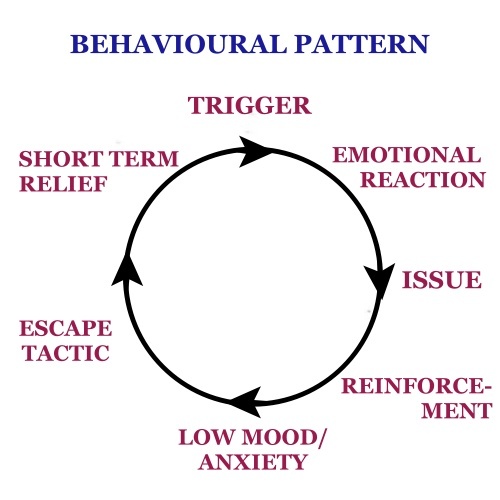Recognising Behaviour Patterns
Maladaptive behaviour refers to actions that are ineffective or counterproductive when adapting to situations. These behaviour patterns often hinder personal growth, coping skills, or social functioning. We have already discussed avoidance as a maladaptive strategy, which can lead to conflict in relationships or work, impacting mental health.
Maladaptive behaviours are usually formed to serve a purpose, such as relieving stress, or to avoid uncomfortable feelings. By understanding their function, we can look at healthier alternatives to fulfil that purpose. We need to recognise the emotional stressors that trigger our maladaptive behaviours. For instance, feeling unwell might lead us to worry that our symptoms indicate a serious condition. If this behaviour goes unchecked, it may escalate and we start to catastrophise, imagining our illness as a life-threatening disease. This fear often originates from past experiences, such as a loved one who visited the doctor and ended up in the hospital for an extended period, or perhaps never returned home. In this case, the fearful emotional memory is the root cause of the catastrophising behaviour, which in turn induces anxiety.
Passive-aggressive behaviour is a defence mechanism that people use to express negative feelings indirectly rather than confronting them openly. This behaviour often stems from an inability or unwillingness to communicate emotions like anger, frustration, or resentment in a direct, assertive way. Instead of addressing issues head-on, individuals who use passive-aggressive tactics engage in subtle resistance, sarcasm, procrastination, or sullen behaviour. This defence mechanism often develops as a way to avoid conflict or the discomfort of expressing anger openly, especially in environments where direct expression of emotions is discouraged or unsafe. While passive-aggressive behaviour may temporarily shield someone from confrontation, it ultimately undermines relationships and personal growth. It leads to unresolved issues and creates confusion or frustration for others, as the true emotions remain hidden behind a mask of compliance or indifference.
Another example of maladaptive behaviours is people-pleasing, especially if it tries to emulate, rather than demonstrate genuine compassion. People-pleasing can be used to gain social acceptance, affection and to boost low self-esteem. This compulsivity arises from the need to be liked, accepted and fit into society.
To uncover the root of a maladaptive behaviour such as catastrophising, people-pleasing or passive-aggressiveness, we must examine our core beliefs, asking ourselves: Who did we feel we had to please in order to survive? And deep down, are we still trying to gain that person’s approval?
It is essential to connect to our authentic self to prioritise our goals and well-being over social approval. When we are guided by our authentic self, we find that our best interest is also for the highest interest of others, this is a natural symbiotic relationship that occurs in the shared fabric of existence.

Trigger and Response.
With guidance and practice, we can learn to recognise triggers that cause a heightened emotional response to an event, person or image. We must identify these triggers in the moment, pause, then using something as simple as three deep breaths to break the automatic link between the emotional stressor and our automatic behavioural response, or reaction.
By taking responsibility for how we manage our emotions, we free ourselves from being ruled by automatic, often impulsive, behaviours that can escalate situations into conflict. Instead, we gain the freedom to choose how we respond, ensuring that our actions align with our values rather than our immediate emotional state.
When emotions are suppressed rather than addressed, they tend to resurface later, often with more intensity, triggered by similar situations from the past. Taking responsibility means acknowledging these emotions and addressing them head-on, rather than letting them fester. Once the emotional intensity cools, reflecting on the situation and the emotions it evoked such as fear, anger, guilt, or something else, gives us the power to understand our patterns and anticipate future reactions.
True Potential.
Taking responsibility is an important step towards realising our true potential. We must hold ourselves accountable for our thoughts, words and actions that negatively impact on our lives and others. Every harsh word from the inner critic of our mind, toward ourselves, shrinks the fulfilment of potential. When our minds are restless and our hearts are troubled, we lose connection with our inner guidance and struggle to know which way to go. When our minds are calm, our hearts open, and we gain clarity.
Through quiet reflection and conscious breathing, we can gain access to inner directive and our truest nature. True self is deeper than flesh, it is a wholesome nourishment in the seed of the individual, propagated by responsibility and freedom. The courage to change helps us to break through the tough shell of mental inertia to realise the fruit of our true design. Healing work is tending to the seed, encouraging it to germinate and casting off the husk of conditioned behaviour and unconscious beliefs. The seed of potential must be nourished by daily mindfulness to expand awareness.
We all have blind spots when it comes to our behaviour, sometimes it takes someone else to challenge us on our difficult or challenging behaviours. When confronted with these blind spots, we often become defensive or deny them, confusing our behaviour with our sense of identity.
An extract from my book A COMPASS FOR CHANGE
For online counselling contact me at : info@colletteomahony.com
or visit my counselling page colletteomahony.com/counselling



